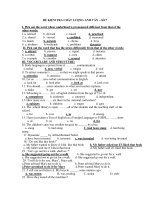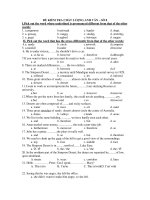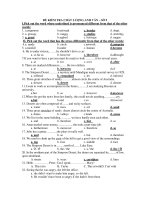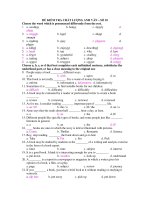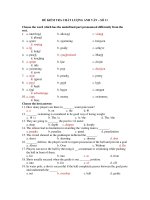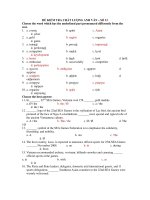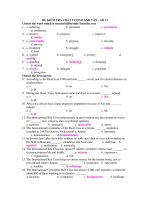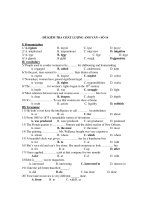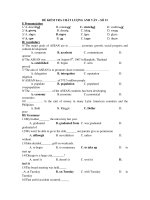ĐỀ KIỂM TRA CHẦT LƯỢNG ANH VĂN – SỐ 3 pptx
Bạn đang xem bản rút gọn của tài liệu. Xem và tải ngay bản đầy đủ của tài liệu tại đây (53.66 KB, 4 trang )
ĐỀ KIỂM TRA CHẦT LƯỢNG ANH VĂN – SỐ 3
I.Pick out the word whose underlined is pronounced different from that of the other
words:
1. a.plant b. danger c. animal d. dam
2. a. species b.causes c.industries d.agencies
3. a. thousand b. around c. sound d. young
II. Pick out the word that has the stress differently from that of the other words:
4. a. species b. danger c. drainage d. reduce
5. a. primary b. diversity c. seriously d.benefit
III. Vocabulary and structures:
6. What John says……….true but I very much doubt it.
a. may be b. will be c. shall be d. should be
7. By cutting down trees, we…… the natural habitat of birds and animals
a. damage b. harm c. hurt d. injure
8. Endangered species are plant and animal species which are…….danger of extinction.
a. off b. in c. on d. with
9. Humans depend……species diversity to have food, clean air and water, and fertile soil
agriculture.
a.for b.in c. before d. on
10. Since the 1600s, worldwide commercial exploitation of animals for food and other
products has ……… reduced the number of rare species.
a. serious b. seriously c. dangerous d. dangerously
11. Different……….efforts have been made in order to save endangered species.
a. conservation b. deforestation c. extinction
d. introduction
12. The Red List is a special book that provides names of……….animals.
a. endangered b. hunted c. vulnerable and endangered d. extinct
13. People keep……….fashionable wildlife products.
a. to buy b. to buying c. buying d. buys
14. There are a number of measures that………… to protect endangered animals.
a. will be taken b. shall be taken c. may be taken
d. should be taken
15.We have enough food at home so we………go shopping today.
a. won’t b. mustn’t c. shouldn’t d. needn’t
16. The by-lows say that all dogs …………be kept on a lead in the park.
a. ought b. need c. must d.have
17. Put some oil on that tight nut; that…….do the trick.
a. might b. must c. had to d. could
18. I hear Emma’s been offered a place at university. She……… be really pleased.
a. can b. might c. may d. must
19. He had to leave early,……….he ?
a. didn’t b. mustn’t c. hasn’t d. shouldn’t
20. It’s not necessary for you to do the test.
a. You needn’t do the test b. You don’t need to do the test
c. You don’t have to do the test b. All are correct
21. When / I / be / school / I / not / wear / uniform.
a. When I was at school, I had not to wear a uniform. b. When I was at school, I mustn’t
wear a uniform.
c. When I was at school, I didn’t have to wear a uniform. d. When I was at school, I
didn’t have to wear an uniform.
22. Louis / have difficulty / get / new table / car.
a. Louis had difficulty getting the new table in the car. b. Louis had difficulty to get
the new table in the car.
c. Louis had difficulty with getting the new table in the car. d. Louis had difficulty for
getting the new table in the car.
23. Wild animals are……… almost everywhere.
a. serious threatened b. seriously threaten
c. seriously threatened d. serious threaten
24. We have got plenty of time. We needn’t yet.
a. to leave b. leaving c. left d. leave
25. If you keep trying ,you might to do it.
a. succeed b. discover c. understand d. manage
IV.READ THE PASSAGE BELOW AND ANSWER THE QUESTIONS.
Read the passage carefully and choose the correct answer.
Species that belong to an area are said to be native species. Typically, they have been
part of a given biological landscape for a long period, and they are well adapted to the
local environment and to the presence of other native species in the same general habitat.
Exotic species are interlopers, foreign elements introduced intentionally or accidentally
into new settings through human activities. In one context an introduced species may
cause no obvious problems and may, over time, be regarded as being just as "natural" as
any native species in the same habitat. In another context, exotics may seriously disrupt
delicate ecological balances and create a cascade of unintended consequences. The worst
of these unintended consequences arise when introduced species put native species in
destruction by preying on them, altering their habitats, or out-competing them in the
struggle for food resources. Although biological introductions have affected
environments the world over, the most destructive, effects have occurred on islands,
where introduced insects, cats, pigs, rats, mongooses, and other nonnative species have
caused the grave endangerment or outright extinction of literally hundreds of species
during the past 500 years.
One of other reason to cause species extinction is overexploitation. This word refers
to the utilization of a species at a rate that is likely to cause its extreme endangerment or
outright extinction. Among many examples of severe overexploitation, the case of the
great whales stands out in special relief. By the middle of the 20th century, unrestricted
whaling had brought many species of whales to incredibly low population sizes. In
response to public pressure, in 1982 a number of nations, including the USA, agreed to an
international moratorium on whaling. As a direct result, some whale species which are
thought to have been on extinction's doorstep 25 years ago have made amazing
comebacks, such as grey whales in the western Pacific. Others remain at great risk. Many
other species, however, continue to suffer high rates of exploitation because of the trade
in animal parts. Currently, the demand for animal parts is centered in several parts of
Asia where there. is a strong market for traditional medicines made from items like tiger
bone and rhino horn.
26.Native species _______.
a. are not used to the local environment
b. never get along well with other native species in the same environment
c. tend to do harm to exotic species
d. have been part of a given biological landscape for a long period
27 .Exotic species _______.
a. do no harm to native species and the local environment
b. may kill native species for food
c. always share the environment peacefully with native species
d. help to make the local environment more ideal to survive
28.According to the first paragraph, _______.
a. non-native species have caused badly damage to native ones
b. introducing new exotic species to local environments is necessary
c. exotic species have never been introduced on islands
d. very few native species have been damaged by exotic species
29.According to the second paragraph, by the middle of the 20 century ___.
a. whale population was the most crowded in marine life
b. whale hunting was illegal
c. whale population increased dramatically
d. whaling was not restricted
30.Tiger bone and rhino horn _______.
a. are not popular in Asian markets
b. are never in the trade of animal parts
c. are used for making traditional medicines
d. cannot be found in Asian markets
Fill in each numbered blank with one suitable word or phrase.
The World Wide Fund for Nature (WWF) is an international (31) _____-
governmental organization for the (32) _____, research, and restoration of the
environment. The organization was (33) _____ as a charitable trust on September 11,
1961, in Morges, Switzerland, under the name World Wildlife Fund. It was an initiative
of Julian Huxley and Max Nicholson.
It is the world's largest independent conservation organization with over 5 million
(34) _____ worldwide, working in more (35) _____ 90 countries, supporting 100
conservation and environmental projects around the world. It is a charity, with (36) ____
9% of its funding coming from voluntary. (37) ___ by private individuals and businesses.
The group says its mission is "to halt and reverse the (38) _____ of our
environment". Currently, much of its work focuses on the conservation of three biomes
that contain most of the world's biodiversity: forests, freshwater ecosystems, and oceans
and coasts. Among other issues, it is also concerned (39) _____ endangered species,
pollution, and climate change. The organization (40) ____ more than 20 field projects
worldwide. In the last few years, the organization set up offices and operations around the
world.
31. a. non b. not c. no d. nor
32. a. challenge b. keeping c. conservation d. awareness
33 .a. produced b. discovered c. used d. formed
34. a. supporters b. residents c. inhabitants d. citizens
35. a. as b. than c. to d. as to
36. a. generally b. individually c. commercially d.
approximately
37. a. deposits b. donations c. refunds d. loans
38. a. destroy b. destructive c. destruction d. destroyed
39. a. on b. by c. with d. upon
40. a. goes b. walks c. reaches d. runs
Mount Everest is the highest moutain in the world. It is in the Himalayan Mountains
between Nepal and China, and it is 8,900 metres high. Sir Edmund Hillary from New
Zealand and Tenzing Norgay from Nepal were the first people ever to climb Mount
Everest. They climbed it in 1953. Men from several different countries climbed it after
that. Junko Tabei, a Japanese from Hokkaido, was the first woman to make this difficult
climb. A Tokyo newspaper-television comnpany organized the climb in 1975. They
choose fifteen women from mountaineering clubs to go to Nepal. The group climbed for
several days. Then there was an avalanche. The heavy ice and snow injured ten of the
women. They had to stop climbing. The other five continued. Only Ms Tabei was able to
climb the last 70 metres. She was standing on top of the world. She was the first woman
there.
26. Where is Mount Everest ?
a. Mount Everest is between Nepal and China.
b.Mount Everest is between India and China
c.Mount Everest is between Negeria and China
d. Mount Everest is between Asia and China
27. How high is Mount Everest?.
a. 8,700 metres b. 8,900 metres c. 8,7500 metres
d.8,9500metres
28. who were the first persons on Mount Everest ?
a. a girl b. a man c. a woman d. b and c
are correct
29. How many women do a Tokyo newspaper-television comnpany choose?
a. fifteen women b. fifty women c. sixteen women d. sixty
women
30. How many women were injured in an avalanche?
a. ten b. fifteen c. eight d. nine

